Local Fishing Categories
Panfish
Simply put, there is nothing more enjoyable to fish for – be it for the youngsters or the rest of the family – than the tasty panfish. Fishing close to shore, in the lake tributaries or around marina docks with live bait like red worms or minnows can be very productive. Yellow perch can be found offshore in huge schools and we are famous for the jumbo variety. Tackle as simple as a hook, sinker and bobber is all you need for a great time with the family – no matter what the age.
Yellow Perch, Rock Bass, Blue Gill/Pumpkinseed, White Perch, White Bass, & Crappie.
Sportfish:
can split into two groups: warm water and cold water species. There are nearshore and offshore opportunities in all of our waters, depending on the time of year. These are a few of the fish that make our region famous and give you the thrill of the catch that will last you a lifetime.
Warm Water:
Walleye, Muskellunge, Northern Pike, Largemouth Bass, & Smallmouth Bass.
Cold Water:
Lake Trout, Chinook Salmon, Steelhead/Rainbow Trout, Brown Trout, Coho Salmon, & Atlantic Salmon
Others:
Some other species to consider include bullhead, catfish, sheepshead and more to make it an exciting day to wet a line and get your heart racing. Carp are gaining recognition and impressive specimens can be caught throughout the region.
Channel Catfish, Bullhead, Sheepshead, Carp, Sucker, Lake Sturgeon (Threatened Species), Round Goby (Invasive Species), & Rudd (Invasive Species)

Atlantic Salmon
This species was once indigenous to New York. Catching an Atlantic salmon is a rare feat, but once you catch one you’ll remember it for a lifetime. Lake Ontario is the only water in the Greater Niagara area currently receiving stockings, with occasional fish showing up in Lake Ontario, the Niagara River and some of the tributaries like Eighteenmile Creek at Burt Dam. Minimum size for these fish is 25 inches long in an effort to protect them. The state record is another Lake Ontario fish, a 24 pound 15 ounce trophy. These fish are often confused with brown trout for identification.

BlueGill / Pumpkinseed
These popular panfish are just what the doctor ordered to keep young kids busy and happy. While these are two different types of fish, they'll often occupy the same waters, such as around sunken limbs, weeds or any type of shallow bottom structure. Red worms are the favorite bait of these feisty scrappers. They can be found in lakes Erie and Ontario, the Niagara River, the Erie Canal and most inland lakes and ponds.
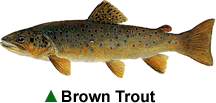
Brown Trout
Most of the brown trout fishing takes place in Lake Ontario portion of Niagara County, although some of the Erie County inland streams may see some stocking. Browns can be found throughout the year in Lake Ontario or its tributaries, with the hotspots being Eighteenmile Creek at Burt Dam; Twelvemile Creek at Wilson; and the lower Niagara River during fall and winter. Come springtime, the big lake is the best spot, trolling the shoreline during April and May. July and August is a good time to target browns out a bit deeper, but inside of 100 foot depths. Placing small spoons on or near the bottom near the thermocline is traditionally the best approach. Fish over 30 pounds have been caught. The state record is 33 pounds, two ounces from Lake Ontario.

Bullhead
These fish can be found throughout the Greater Niagara area, too, with spring being the most popular time for catching these tasty fish. Beware of the sharp spines on the dorsal and pectoral fins. Worms, crabs and minnows are all favorite foods of whiskered fish, but stink bait, chunks of meat or dough balls can all be used to catch these fish, too. The state record brown bullhead is six pounds, nine ounces; the black bullhead is seven pounds, seven ounces.
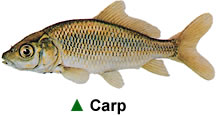
Carp
Carp are quickly gaining recognition as a prized catch in Greater Niagara waters, especially since European anglers started coming over to sample our fishery. The result has been some impressive catches, including some fish over 40 pounds. The state record is a 50 pound, four ounce beast. Carp can be found in most streams, the shallow bays off Erie and Ontario, as well as throughout the Niagara River and Erie Canal system. Worms are a favorite bait, as is corn, dough balls or bread.

Channel Catfish
These fish are really making a mark on the local fishing scene, with a state record fish of over 31 pounds coming from Lake Erie waters in 2002. While that mark has since been broken by a 32 pound, 12 ounce fish, these fish can be consistently caught from May to October throughout Great Lakes waters.
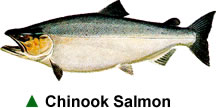
Chinook Salmon
The king salmon is one of the most sought after trophies on Lake Ontario. They can be caught from April through November, with one of the best times being April and May on the Niagara Bar. During the Spring Lake Ontario Counties Derby, more than 50 percent of all winning fish are traditionally caught from these waters. August and September are also good months in the lake from the Niagara River to Olcott. This is when these fish will move into the river and tributaries in an attempt to spawn. The state record fish is 47 pounds, 15 ounces. Occasional salmon will show up in Lake Erie tributaries, but no stocking is currently done in these waters.

Coho Salmon
This cousin of the Chinook normally doesn’t get as big as the king. However, with the world record catch coming from Lake Ontario at 33 pounds, seven ounces, you might get an argument from some. These fish show up in the spring and hang around into the fall when they follow the kings in to spawn. Only Lake Ontario receives stockings of these fish currently, but an occasional fish will show up in Lake Erie tribs. These are also popular fish to target with spoons and spinners off the piers at Wilson and Olcott during the spring when waters are just starting to warm.
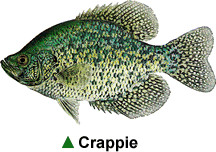
Crappie
Sometimes referred to as Calico bass, these tasty panfish can be found in the shallows of the Great Lakes, the Niagara River and even in the Erie Canal. Both white and black crappie can be found in the Greater Niagara Region with the best bait being a minnow placed two feet below a bobber. They will also hit small artificial lures. Best time of year to catch these fish is spring and fall.
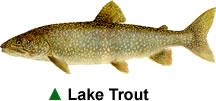
Lake Trout
Lake trout are part of a Federal restoration effort. Each year, New York’s portion of Lake Erie and Lake Ontario receives around 620,000 fish. Lake trout abound in the Greater Niagara Region for a number of reasons. In Lake Erie, the Eastern Basin of the lake is some of the deepest and coldest waters in the lake, affording good angler opportunity for trollers working deep water shoals and reefs with spoons and stickbaits. May through August is the best time. One fish is the limit on this lake, the same body of water the state record comes from at 41 pounds, eight ounces. In Lake Ontario and the Niagara River, lake trout abound from the Niagara Bar to 30 Mile Point for those looking to target them. In the winter and early spring, lake trout actually run up into the Lower Niagara River and are easily accessible from both boat and shore. Out in the lake, these trout can be caught from January until September 30th when the season closes. There is a three fish limit in the lake, but a slot limit of 25 to 30 inches protects prime spawning fish. That could change in 2006 when a proposal could reduce the creel to two per person but allow for one fish inside the slot and one outside the slot. Average size in the river and out in the lake is 10 to 14 pounds. The previous state record of 39 pounds, 8 ounces came from the mouth of the Niagara River. In all of these lake trout waters, you’ve got an excellent chance at catching a 20-pound trophy, with an outside chance at a 30-pound fish!
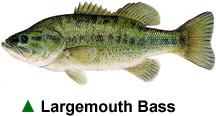
Largemouth Bass
Largemouth bass have made a tremendous comeback to the Niagara Region. The presence of the zebra mussel, along with stringent pollution controls, has contributed to very clear water conditions throughout the Great Lakes. This has resulted in significant weed growth, giving the largemouth a place to grow and prosper. A big bucket mouth over eight pounds was taken in the summer of 2002. Largemouths are found in shallow, weedy areas of the Niagara River, as well as in bays and harbors lining the shores of both Ontario and Erie. Jig and pig along with plastic worms and spinner baits work best.

Muskellunge
Musky is the king of freshwater and this majestic fish grows to mammoth proportions in the waters of Greater Niagara. Proof is the size limit of 54 inches for fish taken in Lake Erie in NY. Below the Peace Bridge in the Upper Niagara River and the Lower Niagara and Lake Ontario the size limit is 48 inches, still a monster of a fish. Catch and release are the way most musky hunters treat their quarry and annually fish in the 40 pound class are sent back to be caught another day. Giant baits trolled with wire line or Fireline are the ticket, although an increasing number of anglers are taking up casting the outside of weed edges to target these fish.

Northern Pike
This first cousin to the musky can be found with frequency throughout the Greater Niagara area. Some of the weedy areas around the Niagara River, as well as some of the harbors off lakes Erie and Ontario, offer good opportunity to catch these toothy critters. Ditto on the Erie Canal, especially in the spring off feeder creeks. A chub fished under a bobber is a favorite shorefishing technique. Other popular baits include spinnerbaits, spoons, stickbaits -- anything with flash. While no one has ever caught anything close to the state record 46 pound, two ounce mark, fish over 20 pounds have been recorded from local waters.
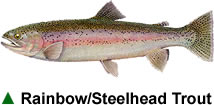
Rainbow/Steelhead Trout
The rainbow/steelhead trout are popular targets and can be caught throughout the year in Greater Niagara waters. These fish can be caught in the tributaries from September through May, depending on water temperatures. During the remaining months, they can be caught in both Great Lakes (Erie and Ontario) by targeting thermal structure in preferred temperature zones. Spoons and stickbaits are the most popular baits for trollers; drifters and casters like using egg sacks, egg imitation baits or live bait like worms or minnows. The top steelhead fishery in Niagara County is the lower Niagara River; in Erie County it’s Cattaraugus Creek and Eighteenmile Creek. All streams with decent water flow will attract fish, however. Record steelhead trout caught August 2004 by Rob Wilson of Ohio 31 lb. 3oz.
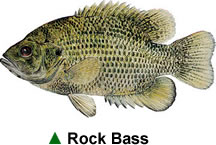
Rock Bass
Often called "redeye," they can be caught spring, summer and fall throughout the Greater Niagara fishing area. Considered a panfish, they can be caught in relatively shallow waters under docks, under overhanging bushes or around any type of bottom structure. Worms, small spinners and wet flies seem to work best.

Round Goby
INVASIVE species
These small exotic invaders spell bad news for the local fish communities. Introduced into the Great Lakes through illegal ship ballast exchanges in the past decade, population levels have exploded and they are starting to displace native species of fish.

Sheepshead
The sheepshead or freshwater drum is the only member of the drum family that lives entirely in freshwater in North America. They are quite common throughout the Great Lakes of Western New York And usually put up a good fight. The ear bones in the head of the fish have long been considered "lucky stones." Average size is only about 15 inches long, but they do get much bigger. The state record catch is currently 24 pounds, seven ounces.
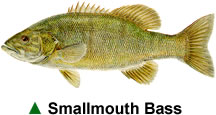
Smallmouth Bass
Smallmouth bass are one reason that so many fishermen come to the Greater Niagara Region each year. Both Lakes Erie and Ontario hold huge numbers of smallies and they grow to trophy size as well. Average catches are 20 to 50 fish a day can be enjoyed throughout the season with fish in the 4 pound class not uncommon. Fish in the super-trophy 6 and 7 pound range show up each year as well. Minnows and crawfish work best for those who choose live bait; tube jigs, grubs and other soft plastics like Reapers take the most fish when using artificials. The state record fish comes from Lake Erie, an eight pound, four ounce fish hauled in during the special early season on Lake Erie. This early season extends from the first Saturday in May until the third Saturday in June when the rest of the state opens up.

Smelt
Rainbow smelt is a popular forage fish in the Great Lakes. Both Erie and Ontario support populations of these tasty baitfish, Which are most accessible in the spring when they attempt to run up feeder streams to spawn. The most noteworthy run is the lower Niagara River in Lewiston, home of the Smelt Festival and the Smelt Capital of the World designation in April. Long handled dip nets are used at night to catch these fish.

Sturgeon
WARNING: Threatened species, must be released immediately if caught
There are many species of sturgeon, but the one that's indigenous to this area is the lake sturgeon. Considered a threatened species in this state, this living fossil has been making a comeback on the local front. These fish are easily identifiable by the sharp bony plates along their back and sides; and by their long pointed snout. Lake sturgeon can grow to lengths of over six feet, weigh in excess of 200 pounds and live to be more than 100 years old. Your best bet at seeing and/or catching one of these fish is in the Niagara River. It is illegal to possess these fish.

Suckers
These fish can be found in most every stream flowing into either Lake Erie or Lake Ontario come spring and early summer. Spearing was once a legal method for taking these fish in the tributaries, but that option is no longer available to anglers. Instead, try fishing with dew worms at night. A state record sucker was caught in the Niagara River several years ago but it failed to make the books because of a low level of awareness. The top white sucker is five pounds, three ounces; the record redhorse sucker is 11 pounds, 11 ounces.

Walleye
Walleye is one of the most popular sport fish anywhere. They grow big and plenty are available here in the Greater Niagara Region. If you want to catch a limit of 4 to 7 pound fish there is no place in North America better than Lake Erie. It’s known as the Walleye Capital of the World! What’s a little known secret, though, is that the Niagara Bar located at the Mouth of the Lower Niagara River/Lake Ontario hosts some of the largest walleye anywhere. Fish in the 14 to 16 pound class are taken (and released) annually and one over 18 pounds has been recorded (although not officially because the state record is 16 pounds, eight ounces). Best baits are spinner and worm for you drifters and slow trollers. For speed trolling Reef Runner Stick Baits and worm harnesses attached to Dipsy Divers and side planers/planer boards work best. A jig tipped with a nightcrawler is also a tough bait to beat.

White Bass
The entire Niagara River was once a fish factory for these fish. Also known as silver bass, population numbers have dwindled a bit. However, they can still be caught with some regularity in the spring and fall by anglers using small silver spoons, spinners, small jigs tipped with twistertails and live bait like worms.
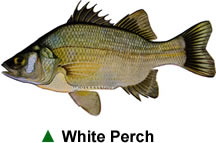
White Perch
The white perch is a close relative of the white bass and striped bass. The most recognizable trait of this silvery fish is its purple throat. It differs from silver bass in that it has a dark back. Small worms are the best bait. They are usually found in six to eight feet of water near the bottom. The state record is three pounds, one ounce.

Yellow Perch
Olive green on the back turning to yellow on the underside with six to eight dark bands on their sides, yellow perch travel in schools so when you find one you'll find more of these excellent eating table fare. These fish can be found in good numbers throughout the Greater Niagara Region, especially in lakes Erie, Ontario and the Niagara River. Spring and fall are the best times to catch these fish with minnows and red worms the best baits. The state record catch is a three pound, eight ounce fish that was reeled in from Lake Erie back in 1982. Current daily creel limit is 50 fish.
 Environment & Planning
Environment & Planning